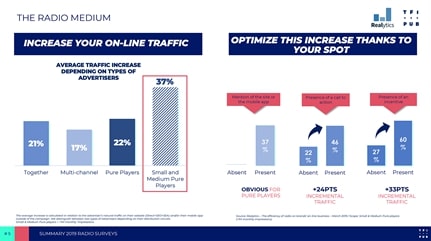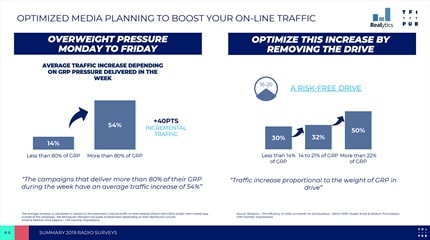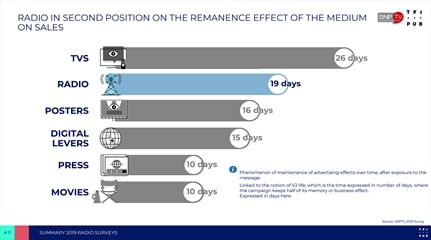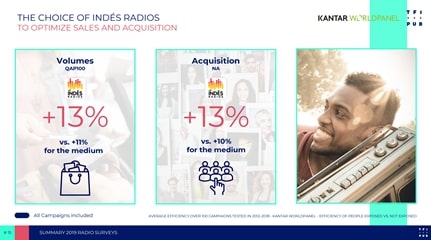http://www.egta.com/egta_bites/egta_bites_290_21022020/index.html
Date: 21.02.2020
To evaluate the effectiveness and efficiency of radio as a medium and advertising channel as well as to demonstrate the strength of TF1’s Les Indés radio brands, TF1 conducted three research studies in 2019. All three studies demonstrate the impact of radio across a range of metrics including contribution to sales and ROI.
1. Radio drives traffic to the web
The two main objectives of the Drive-to-Web Study, done in cooperation with Realytics, was to determine the global impact of a radio campaign on a brand’s on-line traffic and to find creative and media planning levers to optimise the traffic increase.
The study looked at 28 advertisers across different sectors and their 55 campaigns over a three-year period between 2015 and 2018. Forty of these brands were digital advertisers and fifteen were multichannel. The study monitored at least 14 days of consecutive traffic prior to the radio campaign to calculate the increase brought about by the live messages. There were no live messages on TV during the radio campaign.
The results showed that the average online traffic increase was 21% (in relation to the advertiser’s natural traffic on their website and/or their mobile app outside of the campaign). The increase was even higher – 37% – for small and medium digital advertisers (<1M monthly impressions).

The study also showed that the increase in traffic can be optimised thanks to the spot itself. When there was a mention of the site or the mobile app in the spot, the incremental traffic was 37%. In case of a call to action, it was 24% higher than without, similarly, with an incentive, the incremental traffic was 33%.

Media planning optimisation can also boost online traffic. The study showed that campaigns that deliver more than 80% of their GRP during the week have an average traffic increase of 54%.
2. Radio delivers 4.9€ ROI
An econometric modelisation study by the SNPTV aimed to determine the contribution of different media channels to sales and ROI. SNPTV is a French TV trade body and their study analysed the performance of the different factors that contribute to value for campaigns covering five of the largest advertising sectors on TV (food, hygiene & beauty, automotive, pure players, bank & insurance). Fifteen econometric models were devised to analyse the factors that contribute to value over three years. Most importantly, the study was conducted in close cooperation with the five main media agencies. Each of the agencies selected three of their clients to onboard to the study. This also gave the results higher legitimacy as the agencies themselves contributed to the study.

The results showed that for every euro spent radio delivers 4.9€ in terms of sales. When combined with TV, the efficiency of radio campaigns increased by 38%. Radio was also in second position on the Remanence effect of the medium on sales (phenomenon of maintenance of advertising effects over time, after exposure to the message) with 19 days (behind TV with 26 days).
3. Radio campaigns increase sales volumes, client acquisition, loyalty and market share for FMCG brands
Kantar Worldpanel Analysis measured the impact of radio campaigns on sales with and without Les Indés Radios included in the advertising mix. The analysis was conducted on 100 FMCG campaigns between 2012 and 2018 that ran on radio only or on radio and TV.
The results showed radio as an effective medium across all KPIs, in terms of volume (+11%), acquisition (+10%), loyalty (+2%) and market share volume (+10%). Efficiency was measured in terms of people exposed vs. not exposed.

Campaigns that included Les Indés Radios scored even better in terms of volume and acquisition.